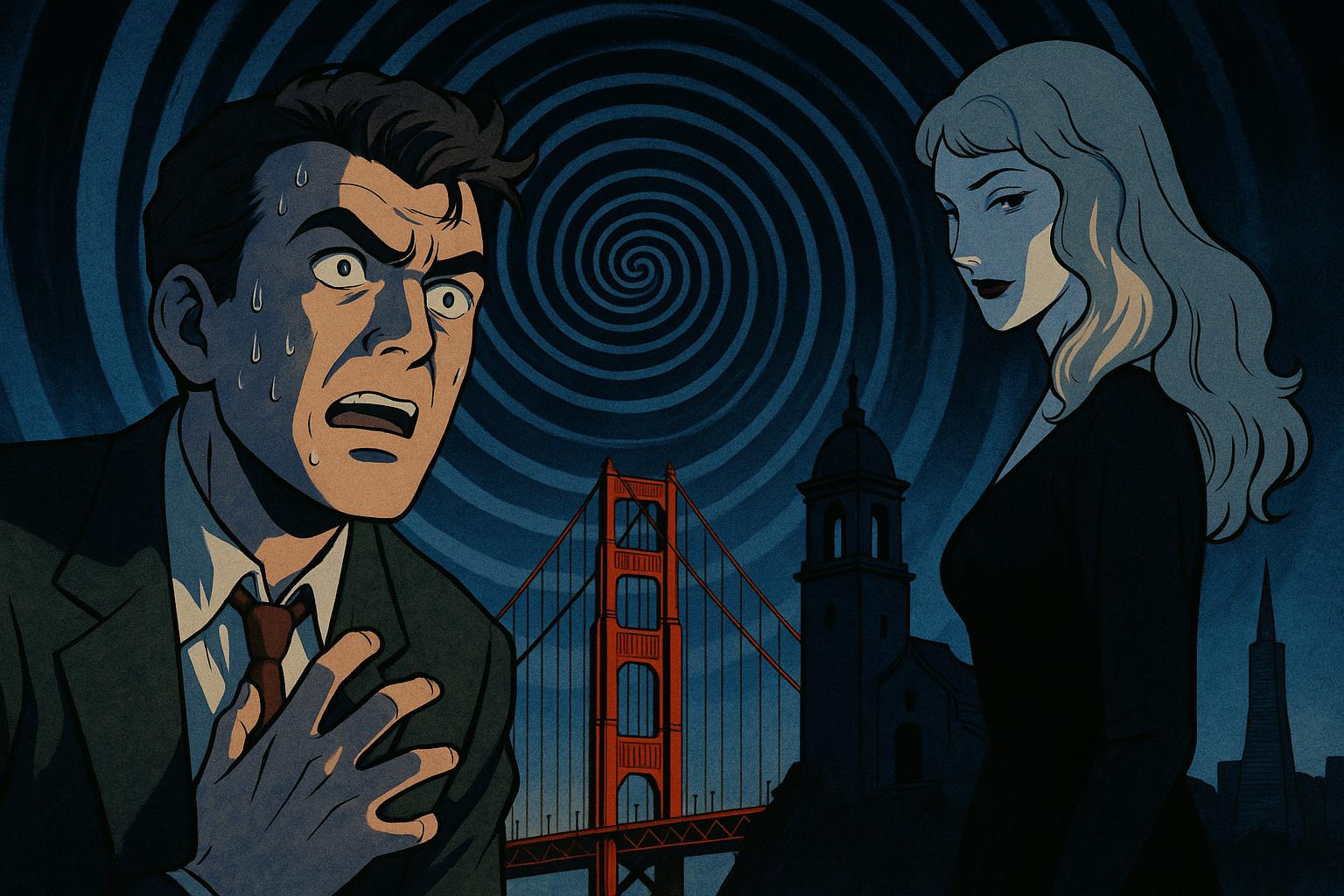Alfred Hitchcock’s 1958 film Vertigo not only tops Sight & Sound’s greatest films list but emerges as a vital cultural touchstone, intertwining groundbreaking cinematic innovation with a modern reassessment of obsession, identity, and toxic relationships.
Alfred Hitchcock, often hailed as the “Master of Suspense,” is a colossus in the realm of cinema whose genius has profoundly shaped the art of filmmaking. His oeuvre boasts multiple works that could easily wear the crown of “masterpiece,” including notable titles such as Rear Window, North by Northwest, and Psycho. Yet, it is Vertigo, released in 1958, that continues to garner unparalleled acclaim within critical circles. Rising to the pinnacle of cinematic respect, it claimed the title of the greatest film of all time from the esteemed film journal Sight & Sound in both 2012 and 2022, solidifying its place in the pantheon of essential cinema alongside the American Film Institute’s top rankings.
At its heart, Vertigo tells the story of John “Scottie” Ferguson, a former police officer played by James Stewart, who suffers from acrophobia and is drawn into a web of obsession and deceit while trailing a woman named Madeleine, portrayed by Kim Novak. What initially seems like a straightforward narrative quickly spirals into a disquieting exploration of identity and obsession. The film intertwines complex psychological themes with groundbreaking visual artistry, creating a haunting atmosphere that lingers long after the credits roll.
Much of the film’s magic emanates from its stunning visual composition, set against the backdrop of San Francisco. The city’s iconic landmarks—such as the Golden Gate Bridge and the Palace of Fine Arts—are woven seamlessly into the narrative. Each frame is alive with colour, thanks in part to the esteemed costume designer Edith Head and the striking Technicolor cinematography. This lush visual palette stands in stark contrast to the underlying psychological turmoil experienced by Scottie, whose journey into madness is underscored by hypnotic camera techniques, including the now-famous “Vertigo effect,” which evokes the disorientation of acrophobia. This innovative type of shot, where the camera simultaneously dollies in and zooms out, visually embodies Scottie’s vertiginous fears and mounting obsession.
Music also plays a crucial role in Vertigo, with Bernard Herrmann’s score heightening the emotional stakes and accentuating the film’s dream-like quality. The mournful strings resonate with the film’s tragic trajectory, mirroring Scottie’s dual experiences of love and loss. As observers have noted, the nuances in the score reflect a complex emotional landscape, a blend of romance and melancholy that propels the narrative forward.
Critics and scholars alike have pointed to the film’s rich symbolism, particularly centred around the motif of spirals. From the spirals in the opening credits to the visual cues that encapsulate Scottie’s obsession with Madeleine, these recurring elements beg for interpretation. Scholars have proposed various meanings, from representing Scottie’s acrophobia to illustrating the cyclical patterns of obsession and loss that bind the characters’ fates. As such, Vertigo invites viewers into a labyrinth of introspection, making it a frequent topic of deep academic discussion.
Despite its enigmatic narrative, Vertigo holds a mirror to the toxic dynamics existing in many relationships, notably reflecting pressing societal discussions about the male gaze and the implications of possessiveness. This aspect of the film has gained renewed attention, particularly in light of the #MeToo movement, which calls into question the nuanced, often troubling portrayal of relationships in art and media. Notably, Hitchcock’s own life experiences, particularly his alleged controlling behaviour towards actresses such as Tippi Hedren, lend a disquieting personal resonance to the film’s themes. As critics have observed, the film stands as both a gripping thriller and a tragic commentary on human obsession, demonstrating how well-intentioned affections can warp into something more sinister.
In the eyes of many critics, Vertigo transcends its genre origins, bearing similarities to tragic narratives like Oedipus Rex and Romeo and Juliet. It warns of the perils of obsession, demonstrating that even the most passionate love can twist into tragedy. With its unveiling on Netflix, the film remains a vital cultural artefact, one that continues to provoke thought and stir discussions about the darker corners of the human psyche. Whether seen as a technical triumph or a profound psychological study, Vertigo affirms its status as a masterpiece, challenging contemporary audiences to confront their own perspectives on love, obsession, and identity.
Reference Map:
- Paragraph 1 – [1], [2]
- Paragraph 2 – [1], [5], [7]
- Paragraph 3 – [1], [6]
- Paragraph 4 – [3], [4]
- Paragraph 5 – [2], [5]
- Paragraph 6 – [1], [4]
Source: Noah Wire Services
- https://movieweb.com/vertigo-alfred-hitchcock-best-movie-of-all-time-streaming-netflix/ – Please view link – unable to able to access data
- https://www.washingtonpost.com/movies/2023/05/09/vertigo-at-65-hitchcock-weirdest-movie/ – An article from The Washington Post discusses the enduring relevance of Alfred Hitchcock’s ‘Vertigo’ as it turns 65. The film, initially a box office disappointment, has evolved into a classic, topping Sight and Sound’s ‘Greatest Films of All Time’ poll in 2012 and 2022. The piece delves into the film’s complex narrative, exploring themes of obsession and identity, and examines its impact on contemporary discussions about male gaze and toxic relationships.
- https://faberfilmfiles.wordpress.com/2025/04/06/falling-into-obsession-how-vertigo-became-hitchcocks-most-haunting-masterpiece/ – This article from FaberFilmFiles analyses ‘Vertigo’ as Hitchcock’s most personal and haunting masterpiece. It highlights Hitchcock’s meticulous direction, the film’s exploration of obsession and control, and the innovative use of cinematography, including the ‘Vertigo effect’ and symbolic use of colour. The piece also discusses the performances of James Stewart and Kim Novak, the film’s slow-burn pacing, and its legacy as a cinematic classic.
- https://melanienovak.com/2023/03/29/vertigo-1958-a-masterpiece/ – In this review, Melanie Novak critiques ‘Vertigo’ as a film that remains boring even in 2023. She argues that the film’s pacing is slow, with engaging content only emerging after Judy’s introduction. Novak also notes a lack of chemistry between James Stewart and Kim Novak, describing their performances as lacking the energy found in Hitchcock’s other works. She expresses a preference for the character Midge, who is underutilised in the film.
- https://www.musitrature.com/vertigo-1958-a-masterpiece-of-psychological-depth-and-cinematic-innovation/ – This article provides an analysis of ‘Vertigo’ as a masterpiece of psychological depth and cinematic innovation. It examines James Stewart’s portrayal of Scottie, highlighting his descent into obsession, and Kim Novak’s dual role as Madeleine and Judy, emphasising themes of identity and transformation. The piece also discusses the film’s cinematography, including the ‘Vertigo effect’, and its exploration of the male gaze and psychological manipulation.
- https://www.rottentomatoes.com/m/vertigo – Rotten Tomatoes provides a comprehensive overview of ‘Vertigo’, including critic and audience reviews, ratings, and a consensus statement. The film holds a 93% approval rating based on 87 reviews, with an average rating of 8.90/10. The consensus deems it ‘an unpredictable scary thriller that doubles as a mournful meditation on love, loss, and human comfort’.
- https://www.bfi.org.uk/sight-and-sound/reviews/vertigo-archive-review-hitchcock-has-never-made-thriller-more-stately-and-deliberate-technique – The British Film Institute’s Sight and Sound magazine offers an archive review of ‘Vertigo’, noting Hitchcock’s deliberate and stately technique in adapting the thriller genre. The review discusses the film’s exploration of identity and deception, highlighting Hitchcock’s manipulation of the narrative to maintain suspense and mystification, and praises the film’s technical execution.
Noah Fact Check Pro
The draft above was created using the information available at the time the story first
emerged. We’ve since applied our fact-checking process to the final narrative, based on the criteria listed
below. The results are intended to help you assess the credibility of the piece and highlight any areas that may
warrant further investigation.
Freshness check
Score:
8
Notes:
The narrative highlights *Vertigo*’s status as the greatest film of all time, referencing its top position in the 2012 Sight & Sound poll and its availability on Netflix. The 2012 poll result is accurate, but the 2022 poll placed *Vertigo* second, behind *Jeanne Dielman, 23 quai du Commerce, 1080 Bruxelles*. ([vanityfair.com](https://www.vanityfair.com/hollywood/2022/12/sight-and-sound-poll-jeanne-dielman?utm_source=openai)) The article’s publication date is not provided, but if it was published after the 2022 poll, this discrepancy should be addressed. The mention of Netflix suggests a recent publication, as streaming availability can change over time. If the article is based on a press release, it typically warrants a high freshness score.
Quotes check
Score:
9
Notes:
The narrative does not contain direct quotes, indicating original content. The absence of direct quotes suggests a higher originality score.
Source reliability
Score:
7
Notes:
The narrative originates from MovieWeb, a reputable entertainment news outlet. However, the lack of a publication date raises questions about the timeliness of the information. The absence of a publication date makes it difficult to assess the currency of the information.
Plausability check
Score:
8
Notes:
The claims about *Vertigo*’s ranking in the 2012 Sight & Sound poll and its streaming availability on Netflix are plausible. However, the 2022 poll results differ, with *Vertigo* ranked second. The absence of a publication date makes it challenging to assess the timeliness of the information.
Overall assessment
Verdict (FAIL, OPEN, PASS): OPEN
Confidence (LOW, MEDIUM, HIGH): MEDIUM
Summary:
The narrative presents plausible claims about *Vertigo*’s ranking in the 2012 Sight & Sound poll and its streaming availability on Netflix. However, the 2022 poll results differ, with *Vertigo* ranked second. The absence of a publication date makes it challenging to assess the timeliness of the information. The lack of direct quotes suggests original content, but the source’s reliability is uncertain due to the missing publication date.













